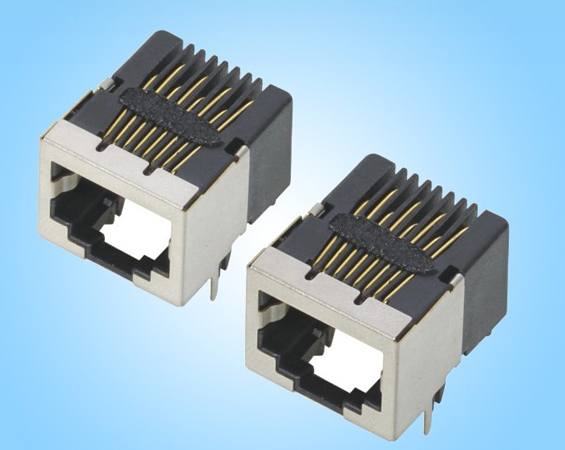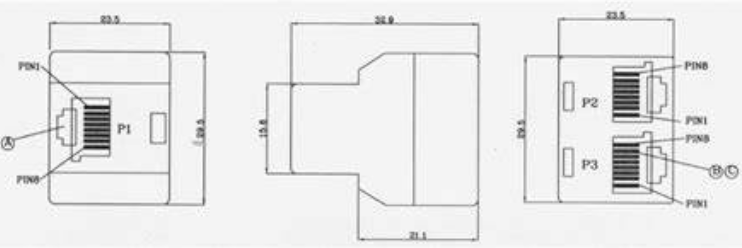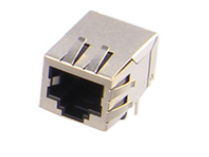While RJ45 jacks are widely recognized as essential Ethernet interfaces, the choice between shielded and unshielded types can significantly affect your network performance. In this article, we'll clearly outline the practical differences between shielded and unshielded RJ45 modular jack connectors, helping you identify the best option for your specific networking environment.
1.What Is an RJ45 Jack Connector?
An RJ45 jack connector is a standardized interface primarily used for Ethernet cable connections, enabling reliable wired network communication. Rather than repeating basic definitions readily available online, let’s focus on practical insights:
Role in Communication:
Acts as a crucial connection point between network cables and hardware devices, facilitating stable and high-speed data transmission.
Real-World Applications:
Widely deployed in home Wi-Fi routers, corporate Ethernet switches, data center equipment, and industrial control systems—highlighting its versatility across multiple network environments.
Learn more:
https://www.glgnet.biz/how-to-test-rj45-jack-connections-a-complete-guide

2.Key Differences: Shielded vs Unshielded RJ45 Jack
|
Feature |
Shielded RJ45 Modular Jack Connector |
Unshielded RJ45 Modular Jack Connector |
|
EMI Protection |
Excellent |
Low |
|
Installation Complexity |
Higher (requires grounding) |
Simple |
|
Cost |
Higher |
Lower |
|
Ideal Environment |
Industrial, outdoor, high EMI |
Office, residential |
|
Cable Compatibility |
STP/FTP |
UTP |
Learn more:
https://www.glgnet.biz/do-you-need-a-shielded-rj45-jacks-for-your-network
3.What Is a Shielded RJ45 Jack?
A shielded RJ45 modular jack connector is a specialized type of connector that integrates a metal housing or conductive shielding material designed explicitly to minimize electromagnetic interference (EMI) and radio frequency interference (RFI). Unlike traditional plastic connectors, this metallic shield directly links to a grounding system, efficiently directing disruptive electromagnetic signals away from the data path. Consequently, this ensures the integrity of data communications, particularly in complex or interference-rich environments.
3.1 Typical Applications
Shielded RJ45 jacks are particularly beneficial in settings that experience substantial electromagnetic disturbances or require stringent reliability, including:
Industrial Factories: For example, facilities using heavy machinery, automation equipment, or motor-driven systems generate substantial electromagnetic noise, necessitating shielded connectors to maintain stable network operations.
Hospitals and Medical Facilities: In medical environments, even minor data interference can lead to critical errors. Shielded RJ45 modular jack connectors provide the necessary protection, ensuring continuous and precise communication among medical devices and patient-monitoring systems.
Outdoor Network Installations: Outdoor installations frequently encounter interference from external sources, such as power transmission lines, broadcasting antennas, or harsh weather conditions. Shielded connectors play a pivotal role in preserving signal quality in these exposed areas.
Data Centers: Data centers demand uninterrupted, high-speed network connections for large-scale data transfer. Shielded RJ45 connectors contribute significantly to maintaining network consistency, reliability, and overall performance stability.

3.2 Advantages of Shielded RJ45 Jacks
Utilizing shielded RJ45 connectors provides several notable advantages:
Robust EMI/RFI Protection: The integrated metal shielding significantly reduces interference from external electromagnetic sources, ensuring consistent and accurate data transmission.
Enhanced Signal Stability: Particularly crucial for mission-critical networks, the shielding ensures stable signal transmission even in environments with high electromagnetic interference, such as industrial plants or data-intensive facilities.
Increased Durability and Reliability: Thanks to the rugged metallic housing, shielded connectors typically offer greater mechanical strength, leading to a longer operational lifespan in demanding environments.
3.3 Potential Drawbacks
However, shielded RJ45 connectors also have some considerations:
Higher Initial Investment: Due to the added complexity and materials required in manufacturing shielded connectors, they are generally costlier compared to their unshielded counterparts.
Complex Installation and Grounding Requirements: Proper grounding is essential to achieving effective EMI protection. This adds complexity during installation, requiring skilled technicians and potentially extending the installation time and effort.
4.What Is an Unshielded RJ45 Jack?
An unshielded RJ45 jack, commonly known as a standard Ethernet connector, is typically constructed from plastic without any metallic casing or external shielding layers. Unlike its shielded counterpart, it does not include additional protective measures against electromagnetic interference (EMI) or radio frequency interference (RFI). This simplicity in design makes it the most widely used type of connector for everyday Ethernet networking in low-interference environments.
4.1 Typical Applications
Unshielded RJ45 connectors are the preferred choice for scenarios where EMI or external noise interference is minimal or negligible. Common usage includes:
Residential Networks: Ideal for home setups involving basic routers, modems, and personal computing devices. Typically, these environments experience minimal electromagnetic disturbances.
Offices and Commercial Spaces: Commonly utilized in office environments for standard computing tasks, printers, internet browsing, and VoIP phones, where interference levels are generally low and manageable.
Educational Institutions: Schools and universities often use unshielded connectors in classrooms, computer labs, and administrative buildings due to their ease of installation and budget-friendly nature.
Small Businesses: Suitable for smaller commercial facilities or retail spaces where the simplicity of setup and cost-effectiveness outweigh the need for extensive shielding.

4.2 Advantages of Unshielded RJ45 Jacks
Unshielded RJ45 jacks offer several practical benefits:
Cost-Effective: Due to their straightforward design and minimal material requirements, unshielded connectors are significantly more economical, making them suitable for larger-scale deployments or budget-sensitive projects.
Ease of Installation: Without the need for specialized grounding procedures required for shielded connectors, installation is simpler, quicker, and more straightforward, reducing labor costs and complexity.
Widely Available and Compatible: Unshielded connectors and cables are widely available, making them easy to source, replace, and integrate with standard networking hardware and infrastructure.
Adequate Performance for Most General Uses: For typical network usage in homes, offices, and educational facilities, unshielded connectors provide sufficient bandwidth and signal quality to handle everyday network tasks efficiently.
4.3 Potential Drawbacks
However, unshielded RJ45 connectors also have certain limitations:
Vulnerability to EMI/RFI: Because there is no shielding mechanism, these connectors are more susceptible to electromagnetic noise, potentially leading to signal degradation or transmission errors if placed near interference sources such as large appliances, machinery, or broadcast equipment.
Not Ideal for Extended Cable Runs or High-Interference Environments: Unshielded connectors are less suitable for long-distance network cables, especially in areas exposed to significant electrical or electronic interference. In such scenarios, signal integrity may degrade noticeably, causing network instability or data loss.
5.How to Choose the Right RJ45 Jack for Your Network
Choosing between shielded and unshielded RJ45 connectors is essential for creating a stable, effective network. Here are some clear guidelines to help you make the best choice:

5.1 Network Environment
High Interference Areas:
Shielded RJ45 connectors are ideal in settings exposed to significant EMI or RFI, such as industrial facilities, hospitals, or outdoor networks near heavy machinery.
Low Interference Areas:
Unshielded connectors work perfectly well in typical homes, small offices, or areas with minimal electronic noise.
5.2 Cable Distance and Bandwidth
Longer Cable Runs or High-Speed Networks:
Shielded connectors protect signal quality over longer distances or high-bandwidth applications (e.g., Gigabit Ethernet and above).
Shorter Cable Runs (up to 50 meters):
Unshielded connectors usually provide adequate performance for standard networks.
5.3 Budget and Installation Considerations
Budget-Friendly and Simple Installation:
Unshielded connectors are less expensive and easier to install, suitable for most general purposes.
Higher Performance, Installation Complexity Acceptable:
Shielded connectors offer superior performance but require proper grounding, adding complexity and cost.
5.4 Industry Standards and Compliance
Certain industries, like healthcare, manufacturing, or critical infrastructure, often require shielded connectors due to regulatory standards.
Consider future expansion or upgrading plans; investing in shielded connectors initially might enhance long-term network performance.
5.5 Practical Recommendations by Scenario
PoE and Industrial Networks: Shielded connectors are preferred for robust EMI protection and stability.
Data Centers and Server Environments: Shielded connectors are strongly recommended to maintain optimal performance and reliability.
Residential and Small Offices: Unshielded connectors generally provide sufficient, cost-effective solutions.
Making Your Final Decision
By carefully considering your network environment, performance requirements, budget, and compliance obligations, you can confidently select the RJ45 connector type that ensures lasting reliability and efficiency.
Learn more:
https://www.glgnet.biz/choosing-right-rj45-jack
https://www.glgnet.biz/enhancing-network-efficiency-with-quality-rj45-jacks
https://www.glgnet.biz/top-10-rj45-jack-manufacturers
Conclusion:
Choosing between shielded and unshielded RJ45 jacks involves careful evaluation of your network environment, performance needs, budget considerations, and compliance requirements. Remember, while unshielded connectors are economical and easy to install, shielded RJ45 coupler jacks offer enhanced protection and reliability in high-interference or demanding applications.